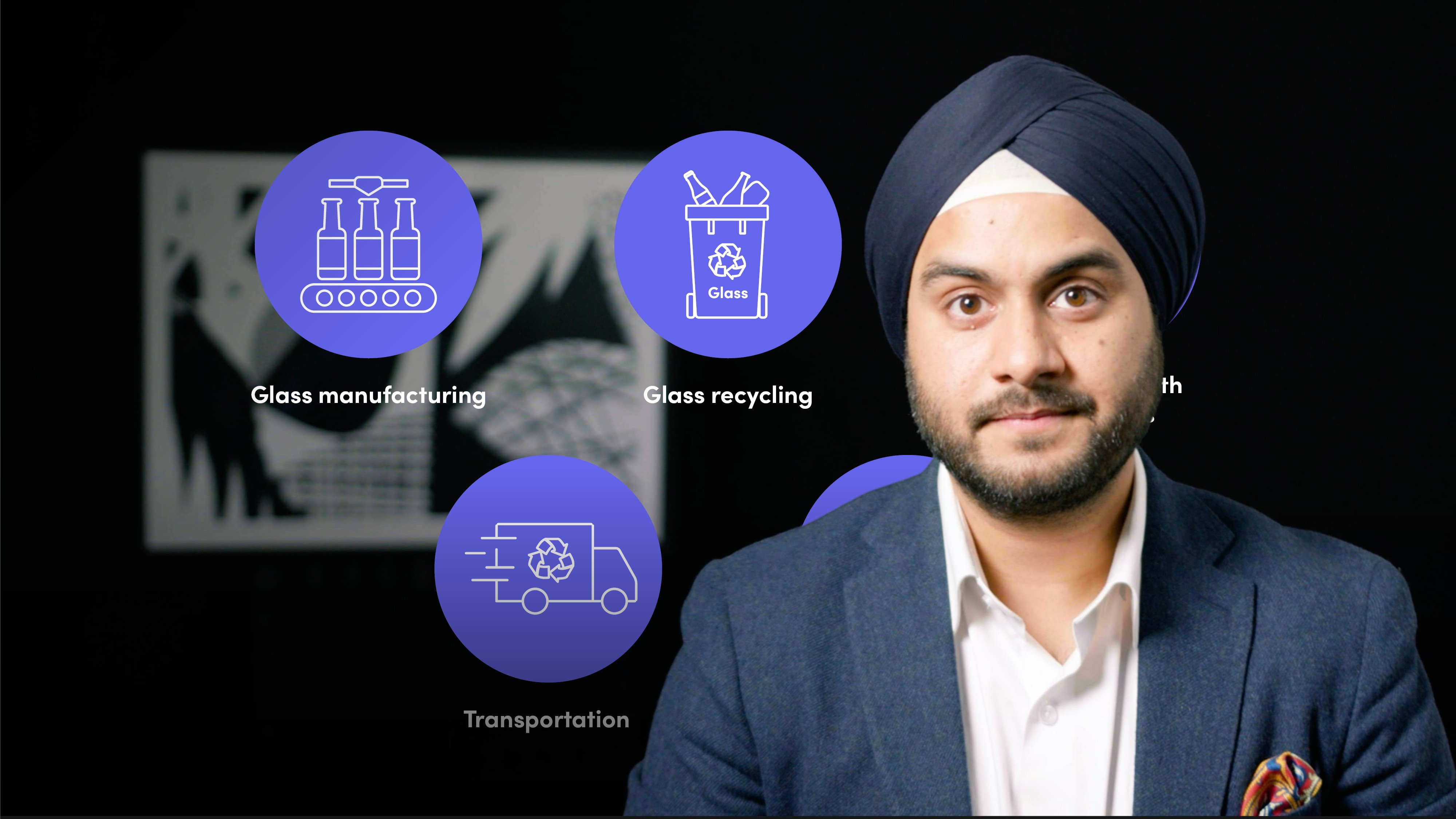
Carbon Life Cycle of Glass Bottles

Sanmukh Bawa
15 yeas: Glass technology expert
In this video, Sanmukh discusses the current impact glass bottles have on the environment, examines the life cycle of a glass bottle from the manufacturing process through the recycling process after use, and discusses how beneficial it would be to use glass bottles provided we can have efficient recycling mechanisms.
In this video, Sanmukh discusses the current impact glass bottles have on the environment, examines the life cycle of a glass bottle from the manufacturing process through the recycling process after use, and discusses how beneficial it would be to use glass bottles provided we can have efficient recycling mechanisms.

Carbon Life Cycle of Glass Bottles
14 mins 27 secs
Key learning objectives:
Understand that glass bottles are more environmentally damaging than plastic bottles during the production process and the impact of the production process
Understand the benefits of recycling glass bottles
Outline some of the more environmentally friendly alternatives to glass
Overview:
The production and disposal of glass bottles has a larger negative impact on the environment compared to plastic bottles. Glass bottles often end up in landfills due to a lack of mandatory recycling, and the production process releases large amounts of CO2, greenhouse gases, and other pollutants. The global market for glass packaging is expected to reach 922.43 billion units by 2026. Glass bottle recycling reduces air and water pollution and saves energy in the production process. A 10% increase in recycled glass, also known as cullet, in the furnace can reduce energy use by 3% and CO2 emissions by 5%. A Cradle to Cradle Life Cycle Assessment found significant CO2 savings in a closed-loop recycling system.
Why are glass bottles more environmentally damaging than plastic bottles?
Glass bottles have a larger carbon footprint compared to plastic bottles. Despite popular belief, glass bottles are rarely reused or recycled, leading to 7 million tons of glass being dumped into landfills in the USA in 2018.
The production of glass bottles requires a significant amount of energy and resources, making it 4 times as damaging to the environment as plastic bottles. The glass manufacturing process starts with the extraction of raw materials, leading to land degradation and water pollution. The main emissions come from heating the raw materials in a furnace, which produces greenhouse gases and other pollutants. Although efforts are underway to reduce the carbon footprint of glass production, the manufacturing process is still a significant contributor to global carbon emissions.
Where do the emissions come from in the glass production process?
The emissions come from two main sources: the combustion of natural gas, the most commonly used fuel, which produces CO2, and the release of greenhouse gases such as CO2, nitrous oxides, and sulphur dioxide during the melting process as by-products from the raw materials. The glass manufacturing process is estimated to produce at least 86 million tonnes of CO2 annually and is also known to have an impact on the lungs of those working in close proximity to factories and mines.
The majority of the carbon emissions in the glass production process stem from the melting stage, which requires heating the raw materials, including silica, sand, soda ash, dolomite, and limestone, in a furnace at a temperature exceeding 1500°C. This process accounts for over 75% of the emissions in the life cycle of glass.
What are the benefits of recycling glass bottles?
Recycling glass bottles is beneficial to the environment in several ways, including reducing air and water pollution, conserving landfill space, reducing energy consumption and CO2 emissions, and reducing the need to mine new raw materials. A study by the European Container Glass Federation found that recycling one tonne of glass in a furnace saved 0.67 tonnes of CO2 emissions, leading to a 58% drop in emissions when 100% of virgin raw materials were replaced with recycled glass. However, there are challenges to recycling glass, including issues with the type and purity of glass, cost, and lack of infrastructure in some regions. The glass container industry in Europe aims to collect 90% of all EU waste container glass by 2030.
How does the environmental impact of glass compare to other alternatives?
The environmental impact of glass bottles depends on its usage and recycling practices. As a single-use bottle, it has a substantive carbon footprint, but when reused and refilled more than 30 times, its footprint is smaller compared to other packaging materials. Glass has a high potential for recycling, with up to 80% being recycled, reducing its CO2 footprint by 26.5-40%. However, its effectiveness varies based on recycling collection rates and factors such as separation of different substances.

Sanmukh Bawa
There are no available Videos from "Sanmukh Bawa"





















